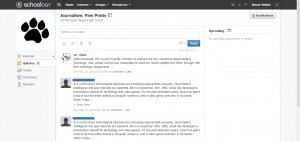Over the years, the technological tools we use in our everyday lives have been making their way into the classroom. Thus digital learning has become a growing concept in the educational world. It sparks a question: How can we use technology to enhance the education of our students?
The Southeastern Regional Student Advisory Council (SERSAC) – a collection of students from schools all over southeastern Massachusetts – has committed their bimonthly meetings this year to the topic of digital learning. Last Wednesday, at their meeting at Bridgewater-Raynham Regional High School, the students of SERSAC began filming their own public service announcement. The PSA will address the “dos and don’ts” of technology in the classroom.
With the assistance of Brittney Hotte, a senior at Old Rochester Regional High School with film editing experience, SERSAC hopes the PSA will be completed and distributed to school committees across Massachusetts by late April.
Here at Old Rochester Regional High School, the technology council is working on its own project. While snow days have disrupted some of their monthly meetings, Megan McKeon, a history teacher at ORR and member of the tech council, said the council is working on creating a long-term plan for technology at ORR. They’ve researched to see what other schools have done, what would be most useful at ORR, and how they can make cost-effective decisions.
“I’m really excited that we have a tech council with really dynamic community members, parents, [and] teachers. We have so many people who want the best for our community,” said McKeon, “The challenge is – how do we get that, especially with the cost? … We also have to keep in mind, technology is changing so fast.”
McKeon recalled how the tech council once believed that the huge TV set in each classroom would be instrumental. However, technology grew in a different direction, and teachers are now more likely to use their projector or Elmo document camera in the classroom.
“Technology is expensive. We’re exploring all options on how to get the best technology here, the best software here – but then we have to be realistic too, and we have to budget,” McKeon said.
ORR does have a number of computer labs available to students. However, Bertrand Allain, an English teacher at ORR, often has trouble fitting his classes of up to thirty students into one lab. Occasionally, students will bring their own laptops in order to participate in online lessons.
“I think that technology is very accessible because it’s everywhere,” said McKeon, “The accessibility is partially because we provide it, but it’s partially because students are bringing in their own laptop, or they’re using their smartphones to do research through the Boston Public Library in my classroom.”
ORR follows a “teacher’s discretion” policy, meaning that each teacher decides when it is appropriate for a student to use their laptop, tablet, or phone during class time. This is a common school policy, although there are some other schools that have established a strict no-technology rule. That viewpoint would argue that school should follow a more traditional path, providing an education without the distractions technology can produce.
ORR, however, has been managing well with their “teacher’s discretion” policy. Most teachers at ORR follow this open-minded view and recognize when technology can be useful.
“Students need to learn how to self-regulate. All of these devices are in their life, whether we like it or not,” said McKeon, “If you have access to those three things [a smartphone, laptop, and tablet] in college, shouldn’t you be practicing in high school how to effectively use them?”
With this idea in mind, ORR has embraced technology. Families and teachers are connected through PowerSchool; the library offers a diverse set of databases for research; history teachers pull docudramas offline to engage the students; English teachers project documents on the board for the class to analyze.
“We can link to anything in the world instantaneously,” said McKeon, “It’s amazing.”
Allain, along with a handful of other teachers at ORR, utilizes a website called Schoology.
“I find it to be a great website because I can organize all of my homework and my assignments in one place,” said Allain, “I feel comforted knowing there’s a central place all of my students can access that has access to their work and their assignments, so that when people are absent, there isn’t a lot of guesswork, there’s always a place you can go.”
While many teachers have expanded the technology in their classroom, ORR hasn’t yet reached its full potential for digital learning.
“We don’t have a ton of technology-based professional development, so at the end of the day I don’t think everyone’s getting a lot of exposure to the technology unless they’re doing it outside of their hours at Old Rochester,” said Allain, “That being said, the school has been super supportive of anything that we do want to use.”
The most regular technology lessons the teachers see are at the staff meetings once a month, where “Ten Minutes of Technology” will occasionally be scheduled. During this time, the school’s technical director presents new software or new tools available to the teachers.
“We talked about things ranging from the really basic things, like YouTube, all the way up to some different websites you can use to do in-class surveys and things like that,” Allain recalled.
“Now if we could only have holograms I’d be really happy,” laughed McKeon.
As ORR deals with the changing times, they’re always looking towards the future as well.
By Renae Reints
